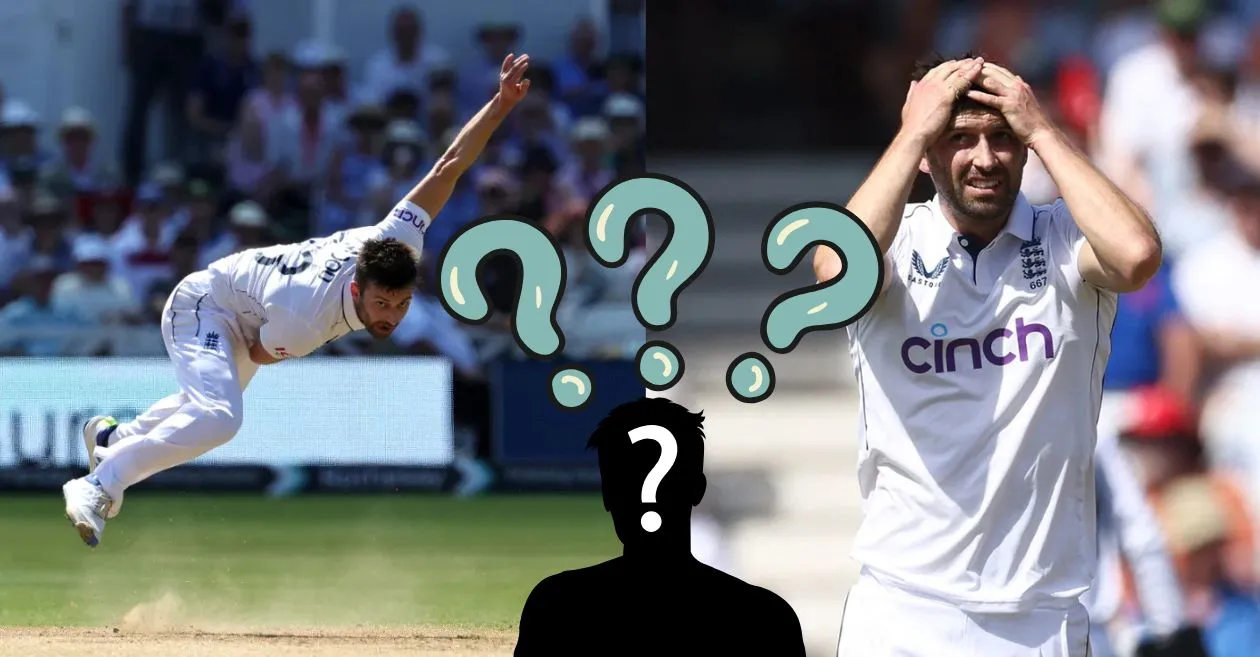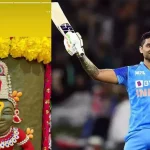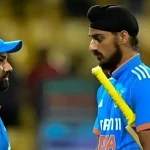Fast bowlers live for the challenge of testing the very best. For England’s speedster Mark Wood, who consistently clocks over 150 km/h, nothing excites more than running in hard against cricket’s finest batters. Yet, even for someone blessed with raw pace and aggression, certain opponents stand out for their resilience, class, and ability to counterattack.
As the dust settled on the 2025 Anderson-Tendulkar Trophy, which ended in a gripping 2-2 draw, Wood appeared on The Overlap Cricket YouTube channel to reflect on his career-defining duels. In a candid conversation, he singled out three Indian batters—Rohit Sharma, Virat Kohli, and Rishabh Pant—as the most formidable adversaries he has faced.
What made these battles special? And why do these three names haunt even one of the world’s fastest bowlers? Let’s dive deep into Wood’s perspective, the stats behind the rivalries, and what it reveals about India’s batting legacy.
Rohit Sharma – The Master of Controlled Aggression
“His bat just kept getting wider”
At the very top of Wood’s list is none other than Rohit Sharma, India’s current all-format captain. The England pacer described bowling to Rohit as a paradoxical battle: every short ball felt like a wicket-taking opportunity, but equally, every mistimed delivery risked sailing into the stands.
“Difficult because against the short ball, you feel like you, for myself, I’ve got a chance of getting him out, but also if he’s on that day, he smokes it,” Wood explained.
The phrase “bat just kept getting wider” encapsulates the psychological battle—Rohit often looked impossible to breach, his timing and placement multiplying the pressure on bowlers.
Statistical snapshot: Wood vs Rohit Sharma
-
Total runs scored off Wood: 229
-
Dismissals: 5
-
ODIs: 113 runs in 9 innings, avg. 56.5, dismissed twice
-
T20Is: Strike rate over 133 against Wood
-
Tests: 92 runs in 4 innings, avg. 46
These numbers show how Rohit thrives especially in limited-overs cricket against express pace, blending controlled aggression with ruthless boundary-hitting.
Why Rohit troubles Wood
-
Pull shot perfection: Wood’s biggest weapon is the short ball. But Rohit, one of the finest pullers in the game, neutralizes it effortlessly.
-
Calm under fire: Unlike many who panic against raw pace, Rohit stays composed, forcing bowlers to overthink their lengths.
-
Patience in Tests, explosiveness in T20Is: Rohit’s adaptability means Wood cannot stick to one plan; what works in red-ball cricket fails in white-ball formats.
For Wood, the cat-and-mouse battle against Rohit encapsulates why he tops the list—every contest feels like a duel between risk and reward.
Virat Kohli – The Relentless Competitor
“Never seemed to miss one”
If Rohit symbolizes elegance and timing, Virat Kohli represents intensity and consistency. Wood admitted that Kohli’s ability to punish even the smallest errors was deeply frustrating. His line of attack was clear—fourth and fifth stump deliveries—but Kohli’s precision left him scratching his head.
“Unbelievable competitor… in that corridor, you think you’ve set him up, but he never seemed to miss one,” Wood remarked.
Statistical snapshot: Wood vs Virat Kohli
-
Runs scored off Wood: 99
-
Dismissals: 1 (across all formats!)
-
ODIs: Rarely troubled, average in excess of 90 against Wood
-
Tests: Solid defensive technique, rarely nicking off
-
T20Is: Smart strike rotation, minimal risk-taking
The stark figures highlight Kohli’s dominance. For someone who thrives on pace, Wood’s speed has rarely unsettled him.
Why Kohli troubles Wood
-
Supreme judgment outside off-stump: Kohli rarely chases deliveries in the danger zone, nullifying Wood’s best line.
-
Fitness and running between wickets: Even when boundaries are hard to come by, Kohli keeps the scoreboard ticking, denying Wood the pressure buildup.
-
Mental battles: Kohli thrives on intensity. Wood, like many bowlers, finds himself drawn into Kohli’s competitive aura, often losing focus on execution.
For Wood, Kohli isn’t just tough technically—he’s a psychological mountain, demanding relentless discipline from start to finish.
Rishabh Pant – The Unpredictable Maverick
“He hits it where he wants”
If Rohit is controlled and Kohli is calculated, Rishabh Pant is chaos incarnate. Wood admitted that Pant’s audacity to improvise and his exceptional hand-eye coordination make him a nightmare.
“He’s got such a good eye, he sort of hits it where he wants. You’ve got to hold your nerve,” Wood reflected.
Pant’s fearless approach forces bowlers into second-guessing themselves. One moment he reverse-scoops a delivery bowled at 150 km/h, the next he’s dancing down to whip it over mid-wicket.
Why Pant troubles Wood
-
Unpredictability: Traditional plans—bouncers, yorkers, slower balls—rarely work consistently against Pant.
-
Counterattack mindset: Pant doesn’t allow bowlers to settle; he turns defense into attack instantly.
-
Left-hand factor: As a southpaw, he disturbs the rhythm of right-arm pacers like Wood, forcing them into awkward angles.
Tactical chess match
Against Pant, Wood emphasized the need for variety—mixing up pace, using slower balls, yorkers, and short deliveries—because repetition is fatal. Unlike Rohit or Kohli, Pant thrives in chaos, meaning bowlers must stay adaptable every ball.
The Bigger Picture: Why Indians Dominate Express Pace
Mark Wood’s list of tormentors is exclusively Indian. This isn’t coincidental—it reflects India’s evolution into a batting powerhouse that thrives even against express pace, traditionally seen as subcontinent teams’ weakness.
-
Technical evolution: Modern Indian batters, from Rohit’s pull to Kohli’s cover drives, have adapted to neutralize fast bowlers.
-
Exposure to global leagues: Players like Pant sharpen their skills against diverse bowling attacks worldwide.
-
Mentality shift: Indian batters no longer merely survive pace; they dominate it. This cultural transformation explains why bowlers like Wood consider them nightmares.
Rivalry Context: England vs India
The Anderson-Tendulkar Trophy of 2025, which ended 2-2, epitomized the depth of competition. England’s pace battery—Wood, Jofra Archer, Ollie Robinson—tested India’s batting, but Rohit, Kohli, and Pant repeatedly stood tall.
Historically, the England-India rivalry has often revolved around bowlers targeting subcontinent weaknesses. But today, Indian batters like Rohit, Kohli, and Pant represent resilience against pace and swing, rewriting old narratives.
Mark Wood’s Legacy Against India
For Wood, his duels with these Indian greats define his international career. At 35, he remains England’s fastest bowler, but his acknowledgment of Rohit, Kohli, and Pant underscores the respect between adversaries.
While he has claimed wickets and enjoyed successes, these batters represent battles where every ball mattered, every mistake was punished, and every breakthrough had to be earned the hard way.
Respect Among Rivals
Mark Wood’s candid revelations reflect more than just statistics—they highlight the mental, technical, and emotional battles that define cricket’s greatest rivalries. Rohit Sharma’s timing, Virat Kohli’s relentlessness, and Rishabh Pant’s audacity present contrasting challenges, but together they form the holy trinity of Indian batting nightmares for Wood.
In admitting their mastery, Wood has paid the ultimate compliment: even the fastest must bow to greatness.
As the cricketing world looks ahead to future duels, fans can only marvel at how such rivalries elevate the sport—pitting the fiercest of bowlers against the most formidable of batters, in contests that leave memories etched forever.
Please check for information on the best betting sites in India – https://selectory.org/best-betting-sites/















